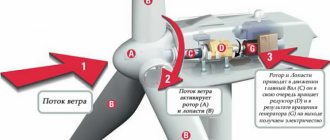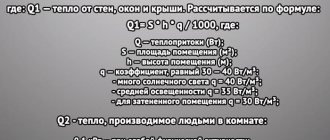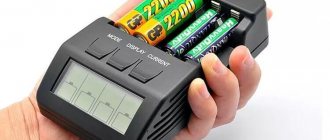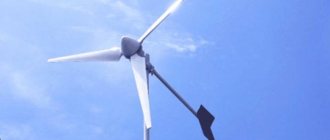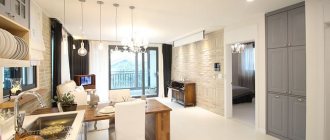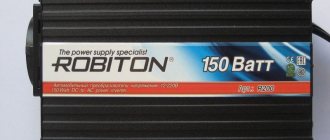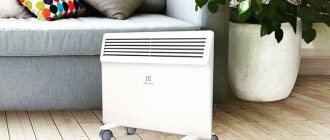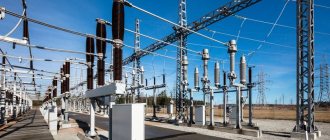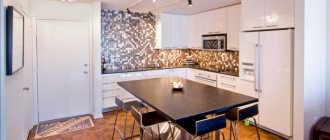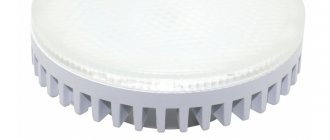SHARE ON SOCIAL NETWORKS
FacebookTwitterOkGoogle+PinterestVk
This article examines in detail this type of equipment, such as a wind generator for a private home: design features, its purpose and scope of application, internal structure and classification. In the text you can find useful information that will help you decide on a quality windmill, average prices for popular types of equipment, as well as a detailed description of the manufacturing technology.
Types and features of wind generators for a private home
All wind turbines are divided into two groups:
- With a vertical rotor;
- With horizontal rotor.
The first type is considered less efficient for generating electricity: its efficiency is almost three times lower than that of horizontal ones.
On a note! Advantages: ease of assembly and reliability. The low noise level makes it possible to install such a device on the roof of the house and at ground level. Such devices are resistant to bad weather conditions (hurricane, ice). They begin to work in a weak wind of 1-2 m/s.
If we talk about horizontal ones, then they require a wind force of at least 3.5 m/s, but these devices are the most common. The efficiency level is 50%, but noise and vibration will be quite high. To install such a device you will need a lot of free space, up to 100 meters, and a tall tree.
Wind turbine with horizontal blade rotor
Horizontal air turbine design
The use of a 220V wind generator for a private home can be justified in several cases:
- inability to connect to the state energy system;
- you can make the device yourself;
- with active participation in the movement for the environmental safety of the planet.
Bright composition of several wind turbines with spiral blades
Note! It simply doesn't make sense to install a wind turbine to power your home, because even if the wind blows constantly at your latitude, it doesn't make the device economically profitable.
How to install and connect a wind station to a house
Power plants are installed by energy specialists. It is impossible to do this on your own without the appropriate knowledge and skills. Energy engineers preliminarily determine the location of the wind turbine on the site. They argue that there should be no tall buildings, plants or other structures nearby that interfere with wind flow.
Important! The electric wind generator should be installed in an open area. The soil characteristics in the area where the wind farm will be installed are also determined.
Windmill installation
To generate sufficient electricity, it is necessary to entrust the installation of a windmill to highly qualified specialists. A preliminary agreement is drawn up with the company. After this, its specialists inspect the installation site of the wind turbine and also prepare the foundation. The next step is to install the windmill. After commissioning, the company’s specialists advise the user on the management of the wind power plant.
If the user wants to install the windmill himself, then he needs to perform a number of steps. Initially, the wind flow speed and other parameters necessary for the operation of the windmill are studied. To determine this, you need to use maps that indicate wind availability. After this, the location of the wind farm is assessed. To do this, equipment is fixed on a hill.
You might be interested in this PSU from an electronic transformer
Note! If the house is surrounded by trees or multi-story buildings, the productivity of the wind turbine will be low.
The mast must be installed in such a way that it is higher than other objects built on the site. The blades should be kept away from trees. The ground at the site of the wind power plant is first leveled and strengthened. The equipment is installed in such a way that access to it is accessible.
We calculate and select a wind generator for your home
Air currents may not always flow toward your home like a gas line. This is a bizarre natural phenomenon that can hardly be called permanent. Today there is a hurricane, tomorrow there is complete calm. Before you buy a windmill for a private home or make one yourself, you should determine the wind power in your region. This is estimated using the average annual wind speed. This option is easy to find on the Internet.
An example of the composition and cost of a wind farm
If you get a force less than 4 m/s, you should not install a windmill because it will not be able to generate the required amount of electricity. Once you have decided when the device can be installed, you need to select a generator based on power.
Calculation of electricity supply in winter
Example of electricity supply in summer
To supply energy to a private house in which a family lives, an average of 300 kWh per month is required. If your region has low wind potential, then you will need a wind generator with a capacity of 2-3 kW. Remember that more electricity is generated in winter than in summer - this is due to the difference in wind speed.
Device components
The wind power plant includes:
- Rotor with blades (wind generators, depending on the model, are divided into two-bladed, three-bladed and multi-bladed).
- In other words, change is change. Its job is to regulate the speed between the rotor and the generator.
- Protective cover: Its name says it all, it is designed to protect all components of the wind farm from external influences.
- The “tail” of a wind turbine is needed to rotate the structure in the direction of the wind.
- Battery: Its main purpose is to store electricity. This is because weather conditions are not always favorable for a wind farm and a certain amount of energy is saved with this component.
- Inverter unit: designed to convert direct current into alternating current. This is necessary to ensure the operation of household appliances.
Which windmill is better: horizontal or vertical?
Wind turbines are divided into types according to the direction of the axis of rotation: horizontal and vertical. Horizontal (dampers) have vertical blades that are attached to a shaft on a horizontal axis. These wind turbines account for about 90% of the market; they are easy to find in any catalog. The popularity of vane wind turbines is due to their high efficiency, easy operation, high hurricane resistance and affordable cost. They can be installed at any height and are not afraid of breakage even during a thunderstorm.
Vertical wind turbines (carousels) are named after the vertical axis of rotation of the rotor. They are easy to assemble and operate consistently even in low winds. Carousel wind generators are quiet and compact, so they are often installed for home use. The disadvantage of such wind turbines is their lower efficiency (compared to bladed ones). A vertical windmill cannot be placed on a tall tree due to its design, so they only work well in windy areas.
Horizontal windmills are more efficient: half of the work of their blades occurs due to resistance to the movement of the oncoming wind. Vertical wind turbines lose power due to changes in wind direction. Horizontal ones require less space and costs, they are efficient and powerful. Low noise levels make vertical wind turbines an attractive purchase, but they will only be a smart purchase for homes that don't require a lot of electricity and have battery storage in calm weather.
Industrial wind generators: a role model
It's no secret that alternative energy really allows you to get electricity literally from the wind. In European countries, industrial wind generators occupy vast areas and operate autonomously for the benefit of people.
They are enormous in size, located in windswept areas, towering above trees and local objects.
And the wind turbines are installed at a distance from each other. Therefore, accidental breakdowns and damage to one cannot cause harm to neighboring structures.
We will take these principles for creating wind generators as the basis for developing homemade devices. They were created according to scientific developments, tested after long-term operation, and work effectively.
Let's start by analyzing the characteristics of the area where we plan to create a wind power plant.
What to look for when buying a wind turbine
It is important to consider the height of the tree. The higher the mill, the more wind it can “catch”. Wind speed increases with height, so even in regions that are not particularly windy, a wind turbine can operate successfully if the mast is high enough. The standard tree height is 10 meters. Every next ten meters the power of the wind flow will increase by one and a half times.
Please note the following factors:
- the actual volumes of electricity that a wind turbine can generate under the conditions of your site;
- the relevance of the selected model, how long it has been in production and how well other users rated it;
- warranty periods and maintenance intervals;
- wind turbine design life;
- degree of complexity of installation and maintenance.
Posting rules
When installing the device, the following requirements must be taken into account:
- There should be no structures, bushes, trees or other obstacles in the vicinity of the generator to obstruct the free passage of wind flows.
- To prevent noise and interference from work from having a negative impact on others, it is better to place windmills for the home at least 30 meters away from the home.
- To avoid weakening wind flows, it is better to install the mechanism 2-3 meters higher than surrounding obstacles, even if they are located at a distance of up to 200 meters.
The best wind generators for home
Condor Home (Russia)
The series of household wind turbines includes devices with a power of 0.5-5 kW. They can serve as the main or additional source of electricity. Condor Home stations are suitable for operation at low temperatures and are capable of generating energy even in low winds.
Depending on the model, the generator housing is made of plastic or die-cast aluminum, the blades are made of fiberglass. There is an effective dual braking system. The mast is composite, supported by ties, and has a height of 8-12 m. To install these units, a pile foundation or concrete is required. Condor Home wind turbines are completely turnkey products that require no special knowledge or technical skills to operate. The devices are designed for electrification of both single-family houses and small settlements in the context of wind power plants
The basic package includes:
- Shafts and couplers,
- Generator,
- Rotor and blades,
- charge controller,
- Fasteners
Falcon Euro (Russia)
These are high-tech vertical-axis wind turbines with a capacity of 1-15 kW. Used for primary/backup power supply to consumers remote from power lines. They can be used as part of a complex with solar panels and a fuel generator.
Windmills are equipped with powerful neodymium magnets. The initial wind speed to start the installation is 1.5 m/s, nominal is 11 m/s. An installed air brake helps limit wheel speed. The period declared by the manufacturer is 20 years, the factory warranty for the mini central unit is 36 months.
Falcon Euro wind turbines are reliable in operation and unpretentious in maintenance. With the help of devices of this series it is easy to solve the energy problems of local and island facilities
The basic Falcon Euro installation kit includes several functional elements: wind wheel, generator and controller, shaft and integrated parts. The inverter unit and batteries are selected separately.
Wind Motorboat Garden
An unusual color (red) Chinese windmill with a vertical axis of rotation is recommended for use at home, for street lighting equipment.
Peculiarities
- Running at low speed;
- High air flow power;
- Slight vibration;
- Easy maintenance and installation.
Options:
- Weight – 11.74 kg;
- Maximum and rated power – 310 and 300 W;
- Initial, nominal and surviving wind speeds – 2 meters per second, 12 and 45 m/s;
- Voltage – 12/24V;
- Wind wheel diameter – 0.9 m;
- Nylon fiber blades – 5 pcs.;
- Control system – electromagnetic;
- Operating temperature range - -40 ~ 80℃.
WS750
This is another type of wind generator that is offered to those who are seriously thinking about an alternative source of energy.
Characteristics:
- Rated power – 0.75 kW;
- Maximum power – 1 kW;
- (Optional) voltage – 24/48 V;
- Starting, operating and maximum wind – 2.3 m/s, 11 and 40 m/s;
- The braking method for the drilling rig is aerodynamic;
- Rotor – diameter 1.8 m;
- Weight – 28 kg;
- Temperature range – -40 / + 60 degrees Celsius;
- Recommended mast height – 6 m;
- Batteries 12V / 200 Ah – 2 pcs.;
- Mains voltage – 48 V.
Condor Home (1 kW)
The company has extensive experience in the production of all types of wind turbines, which are not a problem to buy today. This allows you to quickly implement developments in the series and improve the characteristics of devices.
Buying a wind generator is a real way to solve the problem of power supply to a private home.
The 1 kW wind generator in question is ready for installation immediately after purchase. It is suitable for operation at low temperatures and provides trouble-free operation for a long time.
Peculiarities
- When purchasing a windmill, the price includes the cost of the controller and shaft.
- Installed on a concrete foundation or welded at a distance of at least 15 meters from the building.
Characteristics:
- Wood assembled from pipes and secured with anchor pins - 8-12 meters;
- Die-cast aluminum or plastic housing;
- Rotor diameter 3.3 meters;
- Fiberglass blades;
- Low-speed generator with permanent magnets (neodymium-iron-boron);
- Braking system – double (electromagnetic and aerodynamic);
- Regulator 12,24,48 volts.
- Power 1000 W at 9 m/s;
- Initial wind speed -2 m/s
- Voltage – 12/24 V;
- Speed range – 3-25 m/s;
- Blades -3;
- Weight (without shaft) -80 kg;
- Service life up to 20 years.
Equipment
- Trees – 1 pc.;
- Rope – set;
- Rotor and generator – 1 pc.;
- Blades – set;
- Fasteners – 1 pc.;
- Controller and passport.
Wind generator HEFEY HY 600L five-blade
Having chosen a wind generator, you can also purchase the five-blade model HY-600L. This low-power unit is designed to work in tandem with solar energy systems. It is also recommended to buy it as an autonomous system for power supply to a village or country house of not very large area. It is also used for stand-alone displays and lighting systems.
Characteristics
- Rated and maximum power – 600 and 750 W;
- Starts with a flow rate of 2 m/s;
- Nominal and maximum wind speed – 12 and 50 m/s;
- Operating temperature range – -40 ° + 60;
- Blades – 5;
- Rotor diameter – 1.75 m;
- Dimensions – 1250x520x250 mm.
Peculiarities
- it is equipped with five blades for launching in light winds;
- Charging controller included;
- Minimum level of vibration and noise;
- Aerodynamic and electromagnetic braking to guarantee safety;
- Nearly perfect blades and shaft ensure high efficiency;
- The operation of the structure does not depend on weather conditions;
- High resistance to strong gusts of wind;
- Use of anti-corrosion coatings;
- Easy to install;
- Easy.
Varieties
In order to choose the right wind generator, you must first take into account its technical parameters. Modern models differ in the following number of characteristics:
- The number of propeller blades. A large number of screw elements complicates the design. However, the more blades, the lower the wind speed needed to start the mechanism.
- Type of blade material. Models with rigid propellers are stronger and more durable, but also much more expensive than their sailing counterparts.
Multi-blade wind generator for your home Source ytimg.com
- The location of the rotation guide. Divided into vertical and horizontal. The former are stronger and more sensitive, the latter have better performance.
- Possibility of changing step characteristics. They differ in models with variable and constant pitch. Products with variable step parameters allow you to increase speed, and therefore productivity. However, they are more complex, bulky and expensive.
Good to know! Factory models widely available today are quite expensive. Therefore, those who want to install such an autonomous power plant often have the question of how to make a wind generator. Homemade analogues are often made from car generators connected according to a circuit with a similar 12-volt battery.
Advantages and disadvantages of wind power plants for home
Like any other equipment, wind farms have both advantages and disadvantages. To decide on the purchase of this device, it is advisable to weigh its strengths and weaknesses.
The popularity of using wind turbines is due to the large number of advantages
Why is it profitable to buy a wind generator (220V) for a private home:
- There are no additional costs since the device does not require fuel to operate.
- Constant monitoring is not needed. The structure itself generates electricity every time the wind blows.
- A relatively quiet and completely environmentally friendly way of generating electricity.
- The device can be used in almost all climatic conditions.
- Part wear is minimal.
Installing a wind generator for a home is accompanied by the following disadvantages:
- the cost of purchasing equipment pays off within 5-6 years;
- relatively low efficiency indicator, which is reflected in power;
- high price of wind turbines;
- to compensate for device downtime on windless days, additional equipment is required - a generator and a battery (the cost of these elements is very high);
- in some modes, internal windmills emit infrasound (the same happens if the equipment was installed incorrectly);
- Regular preventive maintenance is required;
- a hurricane can seriously damage equipment.
Depending on the power of the device and the wind map of the area, a windmill can provide electricity to both a small country house and a large country house
Helpful advice! Before purchasing a wind generator for your home, be sure to calculate the profitability; the price of the equipment may be inflated, and the purchase price will not pay off. To do this, you need to calculate the average power of the house (the power of all electrical appliances is taken into account), assess the area where the equipment will be installed, and find out how many windy days there are in a year.
The most common mistakes when purchasing
Dissatisfied consumer reviews can be explained by the desire to receive a quality product almost free of charge and to save on service and installation work. Therefore, many people buy relatively cheap equipment without really studying the technical characteristics and other nuances.
Since all types of alternative energy are quite expensive and a wind generator is no exception, sellers are trying their best to sell this product to the buyer. When the head of the company explains to his client that with a blade with a diameter of 4 meters he can get a power of 7 kW, for some reason he does not specify what type of wind.
The power of the wind generator will be proportional to the cube of the wind speed and the diameter of the wind wheel. That is, for regions with an average wind speed of 6 m/s, the power will be W6 = 4 * (6 * 6 * 6) = 864 W. The satisfied customer has no idea that his system will actually be 8 times more powerful than promised.
Therefore, when choosing a wind generator, you need to pay attention to: power, rated wind speed, blade diameter, choose the inverter wisely (with maximum efficiency and minimum no-load current).
Minimum wind speed
Unfortunately, there are not many regions in our country where the wind speed is at least 5-7 meters per second. The data is taken on average per year. In the vast majority of habitable latitudes, this same speed is a maximum of 2-4 m/s.
This means that your windmill will not be running most of the time. For stable electricity generation, a wind of about 10 m/s is required.
If the wind in your area is 7 m/s, the generator will operate at a maximum of 50% of its rated value. And if only 2 m/s, then 5%.
In fact, a 2 kW generator will not give you more than 100 watts in an hour.
You'll also have to deal with another wind issue that manufacturers don't mention. Near the ground, its speed is much lower than at the top, where industrial enterprises with a height of 25-30 m are located.
You will install your device at a height of no more than ten meters. Therefore, do not even allow yourself to be guided by wind maps of different sites. This data is not suitable for you.
Manufacturers modestly keep silent about the fact that for their wind resource maps, measurements are made at an altitude of 50 to 70 meters! In addition, turbulence and eddy data are not taken into account.
If you try to raise it above 10 m, you will definitely think about lightning protection. Electrified friction blades, a delightful exhaust bait!
Moreover, for some reason everyone only cares about such a parameter as wind speed, and at the same time they forget about its density or pressure. And the difference for energy is very significant. The dependence of energy production on wind pressure is disproportionate.
Thus, when the wind pressure doubles, the power generated increases eightfold!
In addition, there is some cunning in the specified technical characteristics of generators.
Of course, you can believe this, but only under ideal conditions. Because:
- these readings are taken in a wind tunnel
- and in laminar flow with constant direction and increased density
At your summer cottage, the wind speed may be such that it will not be possible to spin a tree, not to mention generating electricity.
And this is in spring or autumn. It is during this period that the most active movements of air masses occur.
Don't forget that a wind turbine does not idle the turntable, but must spin a generator rotor surrounded by neodymium magnets.
And this is only as long as the electrical potential of the windmill is lower than the battery voltage. When the voltage is sufficient to begin charging, the battery becomes a load.
If you use low-speed designs with a vertical axis of rotation, then there is already an overdrive gearbox. Have you tried turning the accelerator? This design becomes more complicated, weight, windage, and cost increase.
Even in the light of the Northern Fleet's headlights, given the constant wind and polar night, experts prefer to use solar panels. When asked why this is so, the answer is simple: there are fewer problems!
How to determine the profitability of your own power plant
Researchers have proven that the reserve capacity of winds is much greater than all the accumulated fuel reserves of centuries. Among the methods of obtaining energy from renewable sources, windmills have a special place, since their production is simpler than the creation of solar panels. In fact, you can assemble a 5 kW wind generator with your own hands, having the necessary components, including magnets, copper wire, plywood and metal for the blades.
Experts say that a structure not only of the correct shape, but also built in the right place, can be productive and, accordingly, profitable. This means that it is necessary to take into account the presence, constancy and even speed of air flows in each individual case and even in a specific region. If the area periodically experiences calm, calm and windless days, installing a mast with a generator will not bring any benefit.
Before you start making a windmill with your own hands (5 kW), you need to think about its model and type. You should not expect a large energy output from a weak design. And vice versa, when you only need to power a couple of light bulbs in your dacha, there is no point in building a huge windmill with your own hands. 5 kW – power sufficient to provide electricity to almost the entire lighting system and household appliances. If there is a constant wind, there will be light.
Batteries for a wind generator: another problem for the home owner
One of the costly challenges of a wind or solar power plant is the problem of storing electricity, which only batteries solve. They will need to be purchased and updated, and the cost is quite high.
To select them, you need to know the operating characteristics - voltage and capacitance. Typically, composite batteries from a 12 V battery are used, and the number of ampere-hours in each specific case should be determined empirically, based on the power of consumers and their operating time.
You will need to choose batteries for a wind generator from a fairly wide range. I will not limit myself to a full review, but to just four popular types of acid batteries:
- normal car starting;
- Type AGM;
- gel;
- armored.
Sellers do not recommend purchasing starter batteries for wind power plants, since they are designed to operate in critical vehicle operating conditions:
- when stored in the cold, they must withstand the enormous starting currents that arise when starting a cold engine;
- during movement they are subject to vibration and shaking;
- Charging occurs in buffer mode by the generator while the vehicle is moving at different engine speeds.
In which:
- reconditioned batteries, requiring periodic electrolyte levels and topping up with distilled water, are designed for 100 discharge/charge cycles;
- without major repairs - they have a more complex design and the number of cycles is 200.
However, the windmill battery when working inside the house:
- usually placed in the basement, where the temperature, maintained all year round at + 5 ÷ + 10 degrees, is optimal;
- they are not subject to shaking and vibration, they are permanently installed in a stable state;
- they do not receive extreme loads during startup, and when turning on household appliances through the inverter, they work delicately;
- they are charged by the generator with small currents, which have a beneficial effect on the desulfation mode of the plates.
All these are the most favorable conditions for their operation. Therefore, I propose to note this option for those who are not too lazy to periodically monitor the voltage on the banks and monitor the electrolyte level in them.
AGM batteries have a more complex design. They have the same plates, but glass mats are impregnated with acid, which simultaneously act as a dielectric layer. Their discharge/charge cycle is 250 ÷ 400. Overcharging is dangerous.
Gas batteries are also created from a maintenance-free design with a sealed housing and gel electrolyte. They don't really like charging, but are more resistant to deep discharges. Number of calculation cycles – 350.
Armored batteries are among the most modern developments. Their electrode pads are protected by polymers from acid attack. Duty cycle interval: 900 ÷ 1500.
All four types of batteries differ significantly in price and operating conditions. If you take into account the sellers' recommendations, you will have to shell out a pretty decent amount of money.
However, I recommend that you first listen to the useful advice that the owner of solar panels himself gives in his video “How to choose batteries for a wind farm and solar station.”
He has his own opinion on this matter. How you feel about him is your business. However, getting acquainted with information from opposing sources and choosing the most suitable option from it is the optimal solution for a thinking person.
Is it profitable?
To get started you will need:
Decide what energy source the wind generator will have.
It should be:
- The main source of electricity. In this case, all consumers are connected to the installed device, and their power supply is completely dependent on the operation of the wind generator.
- Additional source.
In this case there are two options:
- When consumers receive electricity from traditional electrical grids, some of the power is connected to a wind farm or operated for a period of time. With this use, there is a reduction in the cost of paying bills for electricity consumed by energy supply organizations;
- When using other alternative sources of electricity (solar panels, water turbines, etc.), wind turbines are part of the power grid.
- Learn the advantages and disadvantages of wind generators, namely:
The advantages of using such devices include:
- Wind energy is an inexhaustible and renewable source of energy;
- Economics of plants. After the initial purchase and installation costs, there is no need to pay for the consumed electricity in the future;
- Wind energy is an environmentally friendly source of energy;
- The simple design of the units allows for independent installation and maintenance in the future.
Disadvantages of use include:
- Dependence of plant operation on weather conditions and the presence of wind in the area where the units are located;
- Creation of noise and various interference (radio, communications, television) during the installation process;
- Confiscation of the land on which the generators are installed for active use.
- Study the wind potential of the region where the construction of a wind generator is planned. To do this, you can contact the regional weather service or use information on the Internet.
- Select the type, brand and manufacturer of the equipment.
When choosing devices, the main criteria will be:
- plant efficiency;
- Cost of a set of equipment.
When the necessary calculations were made, the power option was selected, the wind potential and the range of proposed equipment were studied, each individual made a conclusion whether it was profitable to use a wind turbine or not.
Renewable, ecological, green
Perhaps it is not worth reminding that everything new is well forgotten old. People learned to use the power of river flow and wind speed to generate mechanical energy a very long time ago. The sun heats our water and moves cars and powers spaceships. Wheels installed in the beds of streams and small rivers supplied water to fields back in the Middle Ages. One windmill could provide flour to several surrounding villages.
At the moment we are interested in a simple question: how to provide your home with cheap light and heat, how to make a windmill with your own hands? 5 kW power or a little less, the main thing is that you can supply your home with current to operate electrical appliances.
Interestingly, in the world there is a classification of buildings according to the level of resource efficiency:
- conventional, built before 1980-1995;
- with low and ultra-low energy consumption - up to 45-90 kWh per 1 kW/m;
- passive and non-volatile, receiving current from renewable sources (for example, by installing a rotary wind generator (5 kW) with your own hands or a system of solar panels, you can solve this problem);
- energy-efficient buildings that generate more electricity than they need earn money by passing it on to other consumers through the grid.
It turns out that your own home mini-stations, installed on roofs and in courtyards, can eventually become a kind of competition to large power suppliers. And governments of different countries encourage in every possible way the creation and active use of alternative energy sources.
How to speed up your payback
A question of questions. It was, is and will be the most popular and relevant. Especially for residents of central Russia, where the winds are not so strong. How to choose the optimal wind generator in such conditions so that it does not run out and quickly pays for itself?
There are two ways to solve the problem:
- Minimize all costs when operating a wind farm;
- And increasing its productivity.
The first solution has been found and it is outrageously simple, like stewed turnips. Experts advise that instead of a powerful wind generator, install several small wind turbines that start working in the weakest wind, as they have light and flexible blades. Small installations do not require large concrete foundations and are assembled by a few workers rather than specialized crews using a variety of equipment.
And the second way to solve the problem is to install vertical rather than horizontal wind turbines. They are the most sensitive to the “breath” of wind, do not require special maintenance during operation and are ready to work at low altitudes from the surface.
Making and installing a windmill with your own hands
Making a full-fledged wind generator for a private home with your own hands is not easy. Each part of the structure must perform its specific function. A wind turbine is capable of converting rotational energy into electrical energy. If your system provides stable current, then it must be connected to batteries.
Example of turbine manufacturing
Manufacturing a vertical rotor for wind turbines
Batteries cannot be used to store energy, but if they are present, operation will be stable. A mandatory part is an inverter that converts energy into the required voltage of 220V. It is necessary to make a small weather vane with a turning mechanism. The propeller is mounted on a shaft because at high altitude there are more opportunities to find air currents. The support must be reliable and withstand wind loads.
How to connect stator coils
Multi-blade rotor diagram
you need to find and purchase a neodymium generator that will harvest wind energy. The propeller can be sail or screw. To assemble everything and install it on a support, you need to make a concrete base that will hold it securely. Using spacers, it is necessary to fix the tree in a vertical position.
One of the options for preparing the tire carcass for concreting
In order for the installation to serve you for a long time, it is necessary to carry out maintenance and promptly replace worn parts.
Wind generator with three-blade horizontal rotor
Sails are not on ships, but on land
One of the popular trends in wind energy now is the creation of a horizontal generator with soft blades. The main difference is both the material of manufacture and the shape itself: do-it-yourself windmills (5 kW, sail type) have 4-6 triangular fabric blades. Moreover, unlike traditional structures, their cross-section increases in the direction from the center to the periphery. This feature allows you not only to “catch” weak winds, but also to avoid losses during hurricane air flow.
The advantages of sailboats include the following indicators:
- high power at slow rotation;
- independent orientation and adjustment to any wind;
- high weathervane and low inertia;
- no need to force the wheel to spin;
- completely silent rotation even at high speeds;
- absence of vibrations and sound disturbances;
- relative cheapness of construction.
Three little secrets
The first secret is at what height the homemade wind generator will be installed. It is clear that it is easier to install it at a height of several meters above the ground, but then it will not make much sense. It should be taken into account that the higher the wind generator, the stronger the wind, the faster its blades spin and the more energy can be obtained from a homemade power plant.
The second secret is the choice of battery. On the Internet, it is recommended not to be smart and install a car battery. Yes, it’s simpler and, at first glance, cheaper. However, you need to know that car batteries must be installed in a well-ventilated area, require maintenance and their service life does not exceed 3 years. It would be better to buy a special battery. Even if it costs more, it will pay off.
The third secret is which wind turbine is best to make with your own hands: horizontal or vertical? Each option has its own advantages and disadvantages. We will consider vertical wind generators, the operating principle of which is shown in Fig. 2.
"Barrel"
All that remains is to make windmills. You can make a 5 kW rotating structure with your own hands from 3 circles of plywood and a sheet of the thinnest and lightest duralumin. Metal rectangular wings are attached to the plywood with bolts and angles. First, guide grooves in the shape of a wave are hollowed out in each plane of the circle, into which the sheets are inserted. The resulting double-decker rotor has 4 wavy blades attached to each other at right angles. That is, between each two plywood pancakes fastened to the hubs there are 2 duralumin blades curved in the shape of a wave.
This structure is mounted in the center on a steel pin, which will transmit torque to the generator. Self-made windmills (5 kW) of this design weigh approximately 16-18 kg with a height of 160-170 cm and a base diameter of 80-90 cm.
